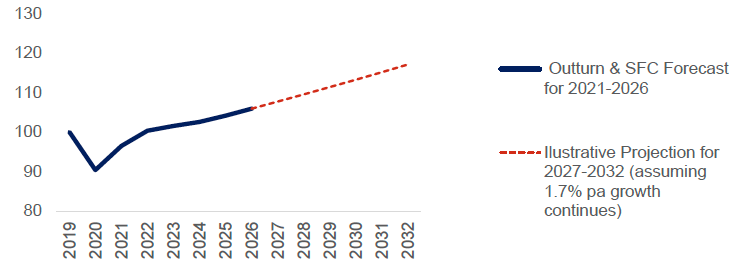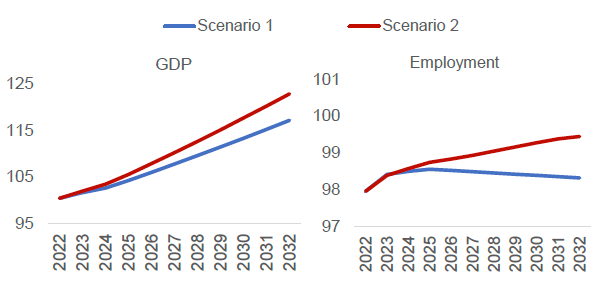Scotland National Strategy for Economic Transformation: evidence paper
This Evidence Paper presents evidence on the structure and performance of Scotland’s economy, and identifies areas where the new National Strategy for Economic Transformation must take action to deliver transformational improvements to Scotland’s economic performance.
4. Economic Modelling of National Strategy for Economic Transformation
4.1 Introduction
This section provides a modelled illustration of how the economy may be impacted by some of the key NSET programmes of action. The NSET programmes of action are wide-ranging. They include actions to improve productivity and competitiveness of existing industries, and also actions that will help to restructure the economy if successfully delivered. The latter includes measures to establish and grow industries in new markets and to address the climate emergency.
The macroeconomic model used in this analysis has no direct link between economic activity and emissions so cannot simultaneously model the impact of transition in terms of changes in output and emissions.[86] This makes it challenging to model the impact of the full package of NSET programme of actions given the scale of the transition. However, we can simulate the impact of improved competitiveness through both trade and investment and also capture some of the wider productivity benefits. The nature of this investment will change given the opportunities and requirements to move to net zero, however, the wider macro impacts will be broadly similar.
For these reasons, the modelled impacts of NSET are based on a few key actions that can be readily captured by existing models. Specifically, this sections looks at two scenarios:
Scenario 1 - Baseline Scenario: this shows how output in the economy could evolve over the next ten years in the absence of policy changes. The outlook is informed by the official economic forecast for the Scottish economy produced by the Scottish Fiscal Commission.
Scenario 2 - NSET Scenario: Models the size of the economy if the package of policies that have recently[87] been announced and that form programmes of actions for NSET are being implemented successfully to achieve their set targets. These include:
- Increasing Exports / GDP ratio to 25% (implementation of export growth plan A Trading Nation);
- Delivering FDI 'spill over' benefits (implementation of Inward Investment Plan: Shaping Scotland's Economy) and benefits from the Global Capital Investment plan; and,
- A small increase in wages across the economy to reflect improvement in productivity and the resulting link through to higher real wages.
In simulating the economic impact, primarily through investment and export channels we recognise that much of this will relate to existing industry but also the new opportunities that emerge as we transition to net zero. Some of these opportunities are set out in Section 3.3 and will represent significant changes to the structure of key parts of the economy.
4.2 Channels of Transmission
The scenario modelled applied to reflect the impact of NSET on the economy operates through a range of channels, including increased trade openness and higher levels of investment, all of which provide a boost to the economy.
An increase in exports through improved access to existing and new markets benefits sectors that trade internationally as well as potential new exporters. Higher economic activity in these sectors increases demand for goods and services in associated sectorsthrough supply chain linkages, thus contributing to the overall expansion in the economy.
Productivity improvements provide a further boost to the economy by increasing economic capacity and through improved competitiveness at home and abroad. Changes in productivity will also depend on the ongoing policy commitment of investing in skills to keep up with evolving labour market demands in a more open economy.
Initially, the modelled effect of the increased labour productivity and increased wages is to slightly lower demand for labour and employment relative to the baseline. With higher wages it is more costly for firms to hire workers and it is assumed that firms require less additional labour due to being able to produce the same level of output with fewer (but more productive) workers. However, in the end these impacts are fully offset by increases in labour demand and the economy adjust to higher output, employment and wage levels with growth.[88]
4.3 Results from Modelling Scenarios
4.3.1 Baseline
Following the recovery, the SFC expect the economy to grow at an average rate of 1.4% per annum, reaching 1.7% in 2026. A range of assumptions could be applied to extend the baseline into the future. For this analysis we have used a simple illustration assuming that the annual growth rate of 1.7% continues beyond the official SFC forecast horizon (i.e. 2027 – 2032),[89] under this assumption the economy is expected to be 17% larger by 2032 than pre-Covid levels in real terms.
As noted in Section 2, Scotland's average GDP growth rate over the period 2000 to 2019 was 1.4% which is somewhat similar to the SFC's assumptions about the future growth rate. This also means that Scotland's international ranking on economic growth among OECD countries is unlikely to change significantly if other countries are able to maintain their historic performance.

Source: Scottish Fiscal Commission, August 2021; SG calculation
4.3.2 Results of NSET scenario modelling
Overall, the economy is estimated to be 4.9% (£8 billion) larger in 2032 than it would otherwise have been the case if the benefits from the package of policies (trade, investment and higher wages) in Scenario 2 not been realised. This also translates into 1.1% increase in employment and 25.1% increase in international exports in 2032 compared to the baseline scenario.
The economy adjusts to the higher level of activity in a gradual way, reflecting gradual introduction of policy changes over the 10-year horizon and short-run constraints.

Source: Scottish Fiscal Commission, August 2021; SG CGE analysis.
Note: the baseline path is a combination of the official forecast produced by the SFC and an illustrative projection which assumes that the 2026 growth rate for GDP and Employment in the SFC forecast applies to 2027-2032. In addition, CGE implied paths for GDP refer to nominal GDP changes as a standard GDP deflator measure is not available in the model but the magnitude of the real change should be roughly similar.
The modelled scenarios would also have implications for the structure of the Scottish economy. Over recent decades, there has been a decline in the relative importance of Manufacturing sector and an increase in importance of Services, reflecting both global and domestic trends.
The model does not provide direct outputs in terms of the structure of the economy in 2032, but if historical trends continued, the share of the Manufacturing sector could shrink further by 2032, although some of that contraction in manufacturing's share is reduced in the modelled policy scenario.
4.4 Modelling Process
All Scenarios are modelled using the Scottish Government Computable General Equilibrium (CGE) model.
The model captures the structure of the Scottish economy and the behaviour of representative agents within it based on underlying theory of economic relationships and econometric estimates of these relationships.[90]
The modelling approach is to run a policy shock through the model, and compare what would happen to the Scottish economy under the "policy scenarios" to alternative baseline scenario – the status quo. As such, this analysis should be interpreted as policy modelling and not a forecast for the economy.
The modelled scenario describes how the economy may be impacted relative to the baseline in 2032. How the economy could evolve over the next 10 years is highly uncertain. The key drivers of uncertainty are the impacts of Net Zero transition and economic recovery from Covid-19, as well as future macroeconomic development paths of major economies and the global economy as a whole.[91]
Reducing industrial emissions will also require significant investment across different sectors of the economy but can also boost productivity. Given the current uncertainties relating to different technological solutions, it is not possible for any one model to simulate the extent of change. In the NSET modelled scenario we recognise that the trade and investment shock, in practise, will reflect different technologies and opportunities.
The long-term impact of Covid-19 on the global economy is also still uncertain as we see the impact on supply changes and logistics feeding into higher energy and related costs.
4.5 Conclusions
- Overall, the modelling illustrates that the economy could be 4.9% (£8 billion) larger in 2032 than it would otherwise have been under the NSET Scenario.
- The modelled package of policies can be thought of as encouraging a more open and productive economy.
- An increase in exports through improved access to existing and new markets benefits sectors that trade internationally as well as potential new exporters.
- Productivity improvements provide a further boost to the economy by increasing economic capacity and through improved competitiveness at home and abroad. Changes in productivity will also depend on the ongoing policy commitment of investing in skills to keep up with evolving labour market demands in a more open economy.
- The ambitions set out in the strategy are broader than the modelled results but these provides an illustration of the benefits of improved competitiveness in improving economic activity relative to the baseline.
Contact
Email: Cornilius.Chikwama@gov.scot
There is a problem
Thanks for your feedback